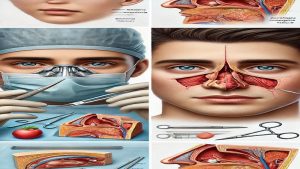Comprehensive review
Introduction
Nose regeneration (Nasal Reconstruction) One of the most sophisticated and subtle procedures of plastic surgery is performed for various reasons, including traumatic injuries, tumor surgery, congenital abnormalities, or cosmetic problems.. The purpose of this surgery is to restore respiratory function, improve appearance and balance facial structure. In this article from the site of Dr. Behnam Khorrami (Isfahan nose surgeon _ Jaw surgeon of Isfahan), Investigating the two main methods of nasal regeneration using artificial tissues and the patient's own tissues (Autologue) Pay.
Anatomy and nasal function
The nose consists of a complex structure including the skin, muscle, cartilage, bone, mucous membrane and soft tissue. Any damage or defect in these structures can cause respiratory problems, appearance deformation, and functional disorders.. Nose reconstruction requires a precise understanding of the anatomy of the nose and the skill in the regeneration of different layers.:
- The outer layer: Includes soft skin and tissue.
- The middle layer: Includes cartilage and bone that forms a nasal support framework.
- Inner layer: Includes the nose mucus that is essential to maintain moisture and respiratory function.
Nasal reconstruction methods
Two main approaches used to rebuild the nose:
The use of synthetic materials
The use of self -ill tissues (Autologue texture)
1.. The use of synthetic materials in nasal regeneration
Synthetic materials used
Synthetic materials used in nasal regeneration are usually of biological materials (biocompatible) Are made to keep their body tissue back. These materials include the following:
Silicon: Flexible, durable and high -forming
Porous polyethylene (Fellow): Have a porous structure that helps to grow natural tissue
Gortex (Gore-Tex): Light, flexible and resistant to infection
Plateau (PEEK): High strength, pressure resistant
Benefits of using artificial materials
No need to remove tissue from other areas of the body
Reduce the duration of surgery
Careful forming and better control over beauty result
Long -term stability
Disadvantages of using artificial materials
Risk of infection
The possibility of moving or rejecting the implant by the body
Non -compatibility with living tissues. In some cases
Cosmetic problems or sensitivity to touch at planting
2.. The use of self -ill tissues (Autologue texture)
In this method, living tissues from different parts of the patient's body are used to rebuild the nose.. These tissues are usually taken from the following areas:
Tissues used
- Cartilage nasal septum: The best source for rebuilding the internal structure of the nose
- Ear cartilage: Flexible and suitable for regeneration of nose
- Gear cartilage: Firm and stable, suitable for reconstruction Nasal bridge
- Skin texture: Of parts such as forehead or species for outer nose cover
- Muscle fascia: To support soft textures and improve beauty result
The benefits of using autologous tissue
Reducing the risk of rejection of transplantation
Improve tissue integrity and adaptation to natural tissue
More natural results due to the use of living tissues
Reduce the risk of infection and inflammation
Disadvantages of using autologous tissue
Need to remove tissue from other areas of the body (Creating a wound)
Increase the duration of surgery and recovery
The possibility of deforming or analyzing tissue with the passage of time
Limit in the amount of tissue available
Comparison
Synthetic tissue
In some cases, surgeons use synthetic materials and autologous tissues to rebuild the nose.. This combined method encompasses the benefits of both methods:
- Use of gear cartilage or septum cartilage for supportive structure
- Use silicon or gortex implants to set the form and create symmetry
- Use of skin tissue or muscle fassia to cover external
Post -nose recreation care
The following care is recommended to improve the results and reduce the complications after nasal regeneration:
Avoid hitting the nose for up to 3 weeks
Avoid heavy activities to prevent tissue displacement
Take anti -inflammatory and antibiotics based on your doctor's recommendation
Care of sutures to prevent infection
Use nasal spray to prevent dryness and cramps
Conclusion
Nasal reconstruction is selected using synthetic materials or their own tissues, depending on the patient's condition, cosmetic and functional goals, and surgeon's experience.. Due to its higher compatibility and natural results, it is a priority, but artificial materials are also a good option due to ease of use, precision formation and reduction of surgery.. The combination of these two methods can provide more ideal and functional results..
Useful links:
Isfahan nose surgeon _ Jaw surgeon of Isfahan
Dr. Behnam Khorrami's page in the clinic 24 | Maxillofacial surgeon in Isfahan clinic 24 | Nose surgeon in Isfahan clinic 24
Dr. Behnam Khorrami, nose surgeon in Isfahan at Dr. Af | Maxillofacial surgeon in Isfahan at Dr. Af | Isfahan nose surgeon at Dr. Af
